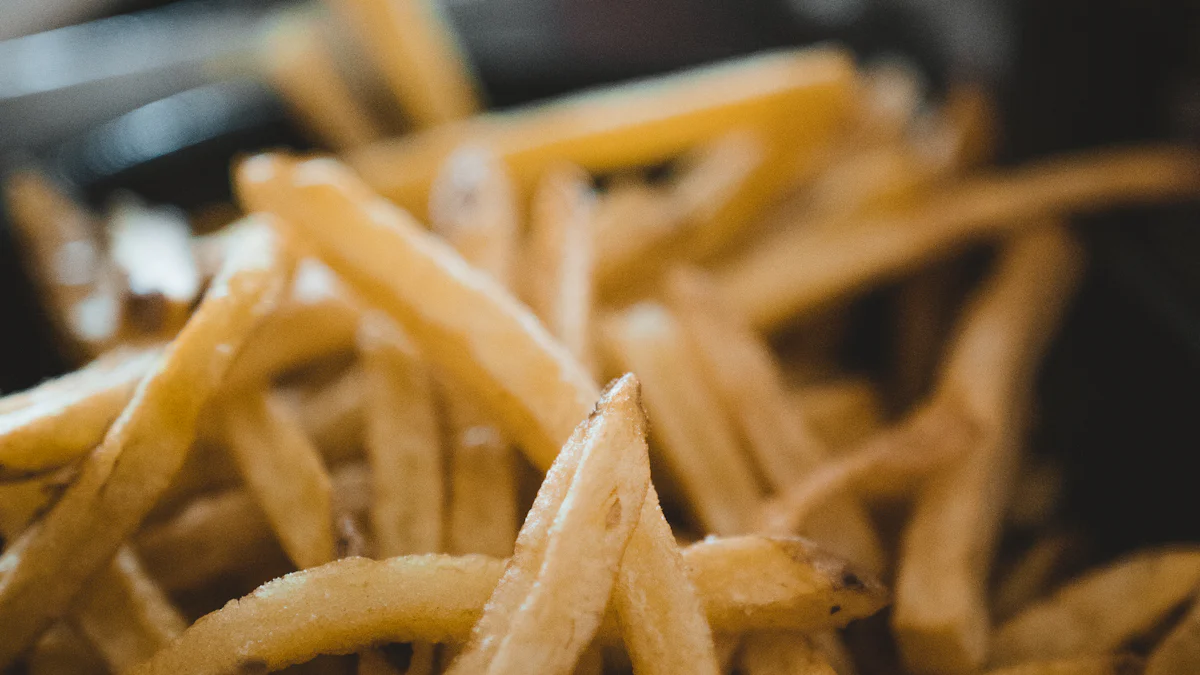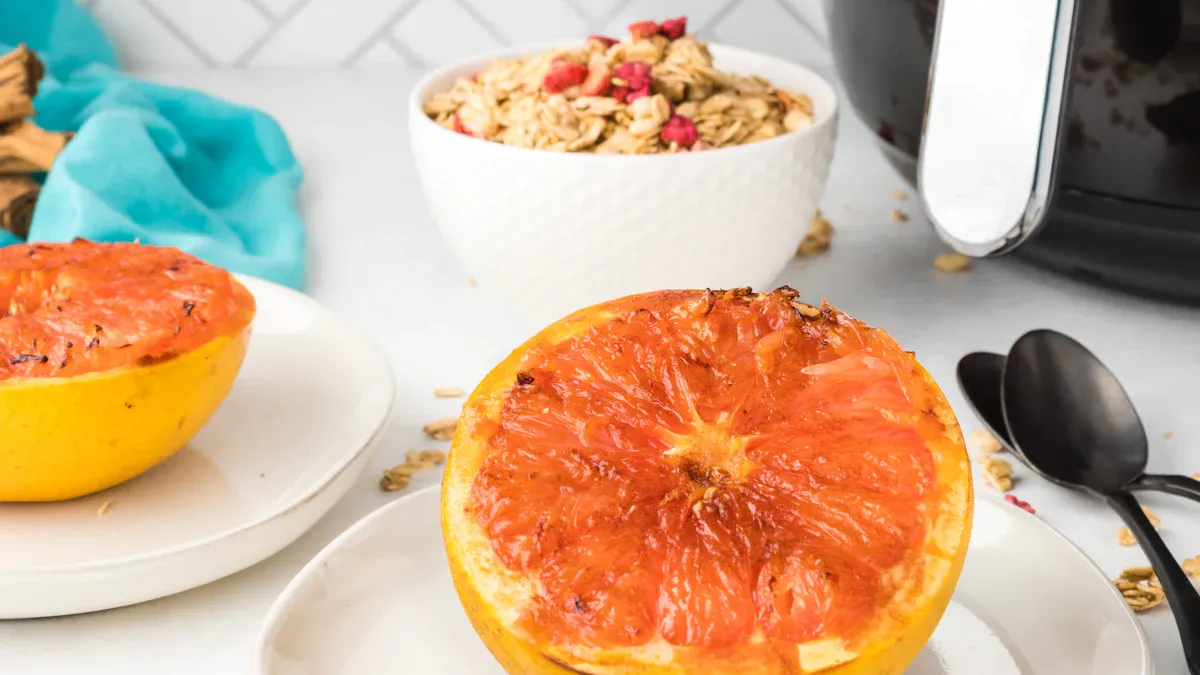
Air fryers have become a popular kitchen appliance, and for good reason. They can reach high temperatures that kill some bacteria on your food. However, you should know that they do not eliminate all germs. Understanding the capabilities of your Household Air Deep Fryer is crucial for ensuring food safety. By knowing how it works, you can make informed decisions about cooking and handling food to protect yourself and your family from harmful bacteria.
Key Takeaways
How Household Air Deep Fryers Work

The Mechanism of Air Frying
Circulation of Hot Air
Your Household Air Deep Fryer uses a fan to circulate hot air around the food. This process mimics the effect of deep frying but without the need for large amounts of oil. The hot air moves rapidly, creating a crispy layer on the outside of the food while cooking it evenly. This method not only reduces the fat content in your meals but also helps in achieving a similar texture to traditional frying.
Cooking Process and Temperature Control
In a Household Air Deep Fryer, you can control the temperature and cooking time. Most models allow you to set the temperature up to 400°F. This high heat is crucial for cooking food thoroughly and can help in killing some bacteria present on the surface. You should always follow the recommended cooking times and temperatures for different foods to ensure they are safe to eat.
Comparison with Traditional Frying
Differences in Cooking Methods
Traditional frying involves submerging food in hot oil, which cooks it quickly and gives it a distinct flavor and texture. In contrast, a Household Air Deep Fryer uses minimal or no oil. This difference not only makes air frying a healthier option but also changes the way food cooks. You might notice that air-fried foods have a slightly different taste and texture compared to their deep-fried counterparts.
Impact on Food Texture and Safety
Air frying can produce a crispy exterior similar to deep frying, but the interior may be less moist. This method can effectively kill bacteria on the surface due to the high temperatures reached during cooking. However, you should ensure that the food is cooked evenly to avoid any cold spots where bacteria might survive. Proper use of your Household Air Deep Fryer can enhance food safety by reducing the risk of bacterial contamination.
Temperatures Required to Kill Common Bacteria
Understanding Bacterial Growth and Survival
Common Bacteria Found in Food
You often encounter various bacteria in food. Some common ones include Salmonella, E. coli, and Listeria. These bacteria can cause foodborne illnesses if not properly handled. They thrive in certain conditions, such as warm temperatures and moist environments. Recognizing these bacteria helps you understand the importance of cooking food at the right temperature to ensure safety.
Temperature Thresholds for Bacterial Elimination
To kill harmful bacteria, you need to cook food at specific temperatures. For instance, Salmonella and E. coli typically die at temperatures above 160°F. Listeria requires slightly higher temperatures, around 165°F, to be effectively eliminated. By reaching these temperature thresholds, you can significantly reduce the risk of bacterial contamination in your meals.
Air Fryer Temperature Capabilities
Maximum Temperatures Achieved
Your Household Air Deep Fryer can reach high temperatures, often up to 400°F. This capability allows you to cook food thoroughly, ensuring that it reaches the necessary temperature to kill bacteria. The high heat generated by the air fryer makes it a valuable tool in your kitchen for preparing safe and delicious meals.
Effectiveness in Killing Bacteria
The effectiveness of your Household Air Deep Fryer in killing bacteria depends on its ability to maintain consistent temperatures. When you set the fryer to the appropriate temperature, it can eliminate most bacteria present on the surface of the food. However, you must ensure even cooking to avoid cold spots where bacteria might survive. By using your air fryer correctly, you enhance food safety and protect your family from potential health risks.
Limitations of Household Air Deep Fryers in Ensuring Food Safety
Factors Affecting Germ Elimination
Uneven Cooking and Temperature Distribution
You might think that your Household Air Deep Fryer cooks food evenly, but this isn’t always the case. The hot air circulates around the food, yet some areas may not receive the same amount of heat. This uneven cooking can leave parts of the food undercooked, allowing bacteria to survive. To ensure even cooking, you should shake or turn the food halfway through the cooking process. This simple step helps distribute heat more evenly, reducing the risk of bacterial survival.
Types of Food and Their Impact
Different types of food require different cooking times and temperatures. Foods with varying thicknesses or densities may cook unevenly in an air fryer. For example, a thick piece of meat might cook well on the outside but remain undercooked inside. You should use a food thermometer to check the internal temperature of meats and other dense foods. This practice ensures that the food reaches a safe temperature throughout, minimizing the risk of bacterial contamination.
Risks of Relying Solely on Air Fryers
Importance of Proper Food Handling
Relying solely on your air fryer for food safety can be risky. Proper food handling before cooking is crucial. You should wash your hands, utensils, and surfaces to prevent cross-contamination. Thaw frozen foods in the refrigerator rather than at room temperature. These practices help reduce the risk of introducing bacteria to your food before it even reaches the air fryer.
Complementary Food Safety Practices
In addition to using your air fryer, you should follow complementary food safety practices. Store raw and cooked foods separately to avoid cross-contamination. Keep your kitchen clean and sanitize surfaces regularly. By combining these practices with the use of your air fryer, you enhance overall food safety. This comprehensive approach protects you and your family from potential health risks associated with bacteria in food.
Best Practices for Using Household Air Deep Fryers to Maximize Food Safety
Pre-Cooking Preparations
Proper Cleaning and Maintenance
You should always start with a clean Household Air Deep Fryer. Regular cleaning prevents the buildup of food particles and grease, which can harbor bacteria. After each use, unplug the fryer and let it cool. Remove the basket and pan, then wash them with warm soapy water. Wipe the interior and exterior with a damp cloth. Ensure all parts are dry before reassembling. This routine keeps your fryer in good condition and reduces the risk of contamination.
Preheating and Food Arrangement
Preheating your Household Air Deep Fryer is essential. It ensures that the food starts cooking at the right temperature, which helps kill bacteria. Set the fryer to the desired temperature and let it run for a few minutes before adding food. Arrange food in a single layer in the basket. Overcrowding can lead to uneven cooking, leaving some areas undercooked. By spacing out the food, you allow hot air to circulate freely, promoting even cooking.
Cooking Tips for Safety
Monitoring Cooking Times and Temperatures
You must pay attention to cooking times and temperatures. Different foods require specific settings to ensure they are safe to eat. Use the guidelines provided in your fryer’s manual or follow recipes closely. A food thermometer is a valuable tool. Check the internal temperature of meats and other dense foods to confirm they have reached a safe level. This practice helps you avoid undercooked food, which can harbor harmful bacteria.
Ensuring Even Cooking
Even cooking is crucial for food safety. Halfway through the cooking process, shake the basket or turn the food. This action redistributes heat and ensures all parts of the food receive adequate cooking. If your fryer has a rotating basket or stirring paddle, use these features to enhance evenness. Consistent cooking reduces the risk of cold spots where bacteria might survive, making your meals safer to consume.
Your Household Air Deep Fryer can kill some bacteria, but it is not foolproof. You must understand its limitations to ensure food safety. By implementing best practices, you enhance the safety and effectiveness of your cooking. Always clean and maintain your air fryer. Preheat it before use. Monitor cooking times and temperatures closely. These steps help you achieve safer meals. Remember, proper food handling and complementary safety practices are essential. They work together with your air fryer to protect you and your family from harmful bacteria.
FAQ
How does an air fryer kill bacteria?
An air fryer kills bacteria by using high temperatures. The rapid circulation of hot air cooks food thoroughly. This process helps eliminate bacteria on the surface of the food. You should ensure that the food reaches the recommended internal temperature for safety.
Can I rely solely on my air fryer for food safety?
You should not rely solely on your air fryer for food safety. Proper food handling is crucial. Wash your hands and utensils. Thaw frozen foods in the refrigerator. These practices help prevent bacteria from reaching your food before cooking.
What types of food are best cooked in an air fryer?
Air fryers work well with a variety of foods. You can cook vegetables, chicken, fish, and even baked goods. Foods that require a crispy texture benefit from air frying. You should follow specific cooking times and temperatures for each type of food.
Do I need to preheat my air fryer?
Preheating your air fryer is important. It ensures that the food starts cooking at the right temperature. Preheating helps kill bacteria more effectively. Set the fryer to the desired temperature and let it run for a few minutes before adding food.
How often should I clean my air fryer?
You should clean your air fryer after each use. Regular cleaning prevents the buildup of food particles and grease. This practice reduces the risk of bacterial contamination. Wash the basket and pan with warm soapy water. Wipe the interior and exterior with a damp cloth.
Can air fryers cook food evenly?
Air fryers can cook food evenly, but you must take precautions. Shake or turn the food halfway through cooking. This action helps distribute heat evenly. Use a food thermometer to check the internal temperature of meats and dense foods.
What is the maximum temperature an air fryer can reach?
Most air fryers can reach temperatures up to 400°F. This high heat allows you to cook food thoroughly. It ensures that the food reaches the necessary temperature to kill bacteria. You should always follow the recommended settings for different foods.
Are air-fried foods healthier than deep-fried foods?
Air-fried foods are generally healthier than deep-fried foods. They require little or no oil, reducing fat content. Air frying also retains more nutrients in the food. You can enjoy a similar crispy texture without the added calories from oil.
Can I cook frozen foods in an air fryer?
You can cook frozen foods in an air fryer. The high heat and rapid cooking process make it suitable for frozen items. You should adjust cooking times and temperatures accordingly. Check the internal temperature to ensure the food is safe to eat.
What should I do if my air fryer cooks unevenly?
If your air fryer cooks unevenly, try rearranging the food. Shake or turn the food halfway through cooking. Avoid overcrowding the basket. This practice allows hot air to circulate freely, promoting even cooking. Use a food thermometer to check for safe internal temperatures.


